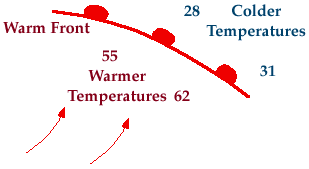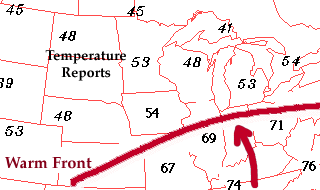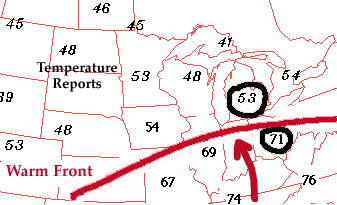|
|
. |
Warm Front
transition zone from cold air to warm air
A warm front is defined as the transition zone where a warm air mass
is replacing a cold air mass. Warm fronts generally move from southwest to
northeast and the air behind a warm front is
warmer and more moist than the air ahead of it.
When a warm front passes through, the air becomes noticeably warmer and more
humid than it was before.

Symbolically, a warm front is represented by a solid line with
semicircles pointing towards the colder air and in the
direction of movement. On colored weather maps, a warm front
is drawn with a solid red line.

There is typically a noticeable temperature change from one side of the
warm front to the other. In the map of surface temperatures below,
the station north of the
front reported a temperature of 53 degrees Fahrenheit while
a short distance behind the front, the temperature increased to 71 degrees.
An abrupt temperature change over a short distance is a good indication that
a front is located somewhere in between.

If warmer air is replacing colder air, then the
front should be analyzed as a warm front. If colder air is replacing
warmer air, then the front should be analyzed as a
cold front. Common characteristics
associated with warm fronts have been listed in the table below.
|
|
Before Passing |
|
While Passing |
|
After Passing |
| Winds |
|
south-southeast |
|
variable |
|
south-southwest |
| Temperature |
|
cool-cold, slow warming |
|
steady rise |
|
warmer, then steady |
|---|
| Pressure |
|
usually falling |
|
leveling off |
|
slight rise, followed by fall |
| Clouds |
|
in this order: Ci,
Cs, As, Ns, St, and fog;
occasionally Cb in summer |
|
stratus-type |
|
clearing with scattered Sc;
occasionally Cb in summer |
|---|
| Precipitation |
|
light-to-moderate rain, snow, sleet, or drizzle |
|
drizzle or none |
|
usually none, sometimes light rain or showers |
| Visibility |
|
poor |
|
poor, but improving |
|
fair in haze |
|---|
| Dew Point |
|
steady rise |
|
steady |
|
rise, then steady |
Table adapted from:
Ahrens, (1994)

Cold Front
|
|

wind shift
|
|




